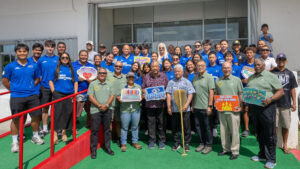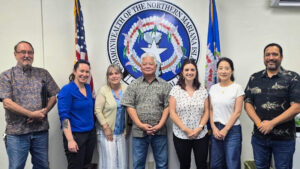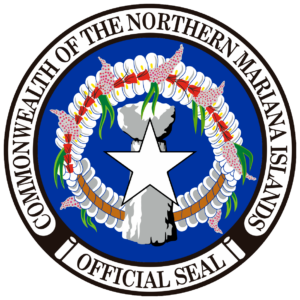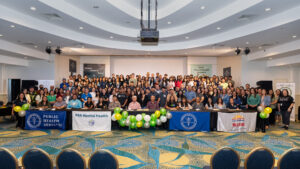WRITTEN TESTIMONY
Ralph DLG. Torres
Governor, Commonwealth of the Northern Mariana Islands
Before the 117th United States Congress,
Senate Committee on Energy and Natural Resources Hearing February 1, 2022
Hafa Adai and Tirow from the Commonwealth of the Northern Mariana Islands (CNMI).
Thank you, Chairman Joe Manchin III, Ranking Member John Barrasso, and Members of this Committee for holding this important hearing to hear about the state of the U.S. Territories. Please accept my apologies for not being able to join in this hearing in person.
When I last appeared before this Committee in 2019, the world was a dramatically different place. The pandemic has altered the way in which the Senate conducts its important business, how millions of people around our nation manage their lives, and has dramatically altered the state of the U.S. Territory of the CNMI. No matter where you reside in the United States, the extent of this outbreak has influenced even the most basic decisions we make on a daily basis. This is truly a global crisis that does not discriminate by border or geography and has certainly reshaped our world.
I emphasize this point because I believe it highlights the reality of life in the CNMI over the last several decades. The singular event of the pandemic impacted the nation’s economy, jobs for millions of hard-working American citizens, and the day-to-day activities of families and neighbors working to adjust to this new world in which we live.
In the CNMI, we firmly believe that we are “Marianas Strong”. Being Marianas Strong is the recognition that we have within us, the resilience to overcome tremendous challenges, uniting even when we disagree, and rebuilding and recovering as one community.
While the nation works toward adjusting to the impacts of the COVID-19 pandemic, we have experienced a decade and more of singular events reshaping our lives over and over again.
Nature has provided these events. Typhoon Soudelor in 2015 and Super Typhoon Yutu in 2018 devastated the islands, destroyed large swaths of homes, closed commercial activity, and reset our understanding of our vulnerabilities against a changing climate.
The global economy has contributed. The withdrawal of a single airline, Japan Airlines, in 2005 eliminated the largest tourism market for the CNMI, resulting in a complete shift in our tourism market, precipitated the decline in commercial activity, left hotels and major shopping centers abandoned, leaving significant numbers without work and a government with diminishing prospects for recovery. This impact was only mitigated by the resurgence of tourism in 2016-17, built upon a dramatically different tourism product to fuel our economy.
And federal actions have contributed. The Consolidated Natural Resources Act of 2008, federalized the CNMI’s immigration system, setting in place a new regime and a transition period that would see the full implementation of U.S. Immigration laws within a given number of years. This law was not without merit, but it is a watershed moment in the development trajectory of the Marianas, placing firm constraints on the levels of growth possible in the CNMI. These constraints were evident when the CNMI reached its CW-1 permit cap in 2016 and were recognized in the extension of the transition period to 2029 through the passage of the Northern Mariana Islands U.S. Workforce Act of 2018.
These events all dramatically reshaped the CNMI, our people, and the everyday lives of our residents. By the time the nation contended with its Great Recession in 2008, the CNMI was already on the track to experience years of economic contraction, unemployment, and austerity to which we only recently began to emerge.
The nature of this present crisis is different for the CNMI in many ways. The secondary impacts of the crisis and the ramifications of our necessary responses to mitigate its spread did levy a disproportionate burden on small, tourism focused economies like that of the CNMI. Since the collapse of the CNMI’s manufacturing sector, the economy is solely reliant on international travel and tourism. This pandemic halted the Commonwealth’s sole economic driver in its tracks, and once more, left the CNMI peering over the edge of another economic depression.
We were not alone this time, however, and our challenges were shared by communities throughout the nation. We were incorporated into national discussion, and most importantly, aided in national response. For this, the people of the Commonwealth and I are extremely grateful for the assistance we have received in the American Rescue Plan Act and thank the members of this Committee for your support of the needs of the territories.
And while the assistance came as a national effort, I believe, the members of this Committee can agree that each jurisdiction has different means of addressing their unique challenges. We are hard at work to mobilize these resources to see a resumption in commercial activity, and the improvement of lives throughout the Commonwealth. Already, through ARPA funding, we have successfully launched the region’s first travel bubble agreement with South Korea, partially resuming this critical tourism market for the community. But the work continues and we look to support our recovery under a keen eye toward accountability and compliance with federal guidelines.
Since the passage of ARPA, the CNMI was once more included into the national conversation of infrastructure rehabilitation and development. For this we are also immensely grateful, however, once more, the challenges of the CNMI present unique challenges from those in the states. I think it is critical as we look at the state of the CNMI that infrastructure, and the associated issues related to its development, remain a necessary element of this conversation.
The CNMI’s infrastructure is in a critical state due to decades of pre-Commonwealth neglect, lack of infrastructure development, extreme natural and weather-related challenges, and an absence of sufficient funding resources. As the newest member of the US political family charged with the complete modernization of a pre-World War II infrastructure and restricted resources, creating a solid and reliable infrastructure system has been an immense challenge.
In 1986, the CNMI inherited from the Trust Territory government a substandard infrastructure of severely dilapidated or completely unpaved roads, pre-WWII water delivery systems, an unreliable power generation system that was often offline, underdeveloped air and sea ports, and a communications system unable to meet the needs of the coming digital age. Much of our new Commonwealth’s infrastructure, roads, water wells and distribution systems, and the power grid, were remnants of the pre-WWII Japanese administration and some later repairs and the paving of some thoroughfares during the post-WWII Naval administration.
At the inception of the Commonwealth, the new government found itself confronted with an over 50-year old and badly degraded road, water, and power distribution infrastructure and environmentally hazardous wastewater and landfill conditions. Wastewater and road drainage systems were largely nonexistent. Air and sea ports, schools, hospitals, and other public facilities were also in significantly substandard states.
The newly formed Commonwealth set out on a course of infrastructure improvement, developing new roads and repaving roads, lighting roadways, replacing water pipes, bringing new water wells online, correcting environmentally hazardous wastewater treatment and expanding the sewer system, bringing new generators online, constructing new solid waste landfill facilities, and a myriad of other efforts to bring the infrastructure and public facilities of the CNMI’s three main populated islands to a state of relative modernity. More recently, two catastrophic tropical storms, super-typhoons Soudelor in 2015 and Yutu in 2018, had devastating effects on the infrastructure of our three major islands, destroying the power grid, damaging or completely destroying public facilities including our airports and most of our schools, and adversely affecting our newly launched public transportation service.
Across the United States, the investment in resilient infrastructure has provided the ability to maintain a safe and adequate foundation for Americans. The CNMI’s modern development has only been witnessed in the last four decades as investment built upon a landscape torn by years of war and colonial rule. The needs and the costs of building quality, lasting infrastructure despite limitations in land mass, separation of lands by the ocean, limited workforce, labor issues, modernization of the permitting processes, and climate change issues for the thousands of American citizens who call these islands home have not been adequately represented in contrast to those of other American communities.
Our infrastructure directly affects the lives of our residents, our economic development, and our environment. Since the start of our Commonwealth, we have made great progress in transforming our road systems, power grids, water and sewage systems, landfills, air and sea port developments, and public transportation. However, we have not had the funding resources necessary to address the breadth of our infrastructure needs, and certainly not in a planned holistic, sustainable, and resilient way.
The recently enacted Infrastructure Investment and Jobs Act aligns with the goals set forth in the CNMI Office of Planning and Development’s (OPD) Comprehensive Sustainable Development Plan (CSDP) , which details infrastructure development across sectors that follow a “Smart, Safe Growth” framework. In partnership with local development planning and regulatory agencies and supported by the US Federal Emergency Management Agency and US Environmental Protection Agency’s Region IX Pacific Islands Office, this framework highlights strategies to ensure thegrowth of communities with thriving economies and healthy environments that are resilient to natural disasters. After experiencing two 100-year super typhoons within a three-year period, the CNMI worked to develop comprehensive planning strategies following this “Smart, Safe Growth” framework that form the intersection of three key areas of practice – hazard mitigation, climate impact adaptation, and smart growth, each of which follow their own policy guidance and best practices.
The Infrastructure Investment and Jobs Act will allow the CNMI to invest in critical infrastructure and address resource needs to ensure that our communities can grow while withstanding current and future weather and climate related challenges with minimal physical damage or disruption to communities. As the CNMI looks at the possibilities made available through federal government assistance, I must reinforce a message that I have brought to this Committee many times before. The U.S. Territories are unique among themselves and among the larger American community. The CNMI proudly flies the American flag, but does so with resource constraints larger than many, if not all, mainland communities. We are limited in our land, limited by our geographic location, limited by the size and scale of our population. This is the environment in which we are striving to achieve viability in a competitive global market, and despite its supreme challenges, I do not wish for these islands I love to be defined by these limitations.
The federal response to the COVID-19 pandemic and the response brought on following Super Typhoon Yutu, truly represents a watershed moment in our history. With these resources, we are presented with an opportunity to not just recover, but to build a viable American community in our region of the world. In lieu of presenting this Committee our list of requests, I want to offer a pathway for us to work collaboratively in ensuring we do not miss this opportunity to see substantial progress for the CNMI that overcomes the limitations that geography and history have provided us.
Labor
The issues of the CNMI’s labor force are well-known by this Committee, and I once more thank you for your willingness to assist in fostering a strong U.S. workforce in the CNMI. I am proud to say that the CNMI has taken the mandates of the Northern Mariana Islands U.S. Workforce Act seriously, and have made considerable progress for U.S. workers in our economy. Through data collected by the CNMI Department of Labor, and through Labor Force Surveys conducted by my office as required under the Act, we now have the highest percentage of U.S. workers in our labor force, earning more per hour than in any other time in recent history. This is a monumental success and should represent a new benchmark in our efforts to build a stronger economy and community for our citizens.
Yet, progress for the CNMI’s labor force and economy have been set back by the global pandemic. As tourism arrivals contracted, and restrictions aimed at mitigating the spread of the virus were implemented, businesses closed their doors leaving thousands of employees in need of assistance. While the Pandemic Unemployment Assistance provided many means to mitigate these impacts, I believe the most critical response effort lies in rebuilding the economy that supported these residents.
We have been working toward the resumption of arrivals to provide essential injection of external resources to the many businesses and employees that support, in one way or another, the tourism sector, and I am proud of the successes we have been able to achieve. However, the tourism economy globally will take considerable time to recover. This is of significant concern for the CNMI as federal resources reach their expiry date, the CNMI has no alternative means to support economic activity.
The deployment of infrastructure development resources has the potential to fill this gap, and allow for the flow of capital to reach our residents. One of the greatest challenges facing the CNMI in the deployment of these funds is the availability and affordability of construction labor in the CNMI.
Under U.S. Public Law 115-218, CNMI employers are restricted from utilizing the CW-1 Visa Program for the acquisition of construction workers for projects not related to a presidentially declared disaster. This dramatically limits the available manpower to support public infrastructure projects provided in the Infrastructure Investment and Jobs Act, as it is not in relation to a declared disaster.
Labor acquisition is further impeded by high transportation costs because of our geographic location and federal regulations governing air and sea transportation to the island. Communities around the United States are experiencing similar labor challenges. The U.S. Home Builder Institute in 2021 stated that a “lack of skilled construction labor is a key limiting factor for improving housing inventory and housing affordability” with the research supporting the estimation that the U.S. economy needed 2 million more construction workers in the labor force to meet this demand.1 Further, the nation is experiencing the challenges the CNMI has faced for decades, namely not enough U.S. workers in the labor force to support economic growth.2 These issues remain present in the CNMI but are vastly more severe and require a distinct set of solutions.
As indicated in the recent CNMI Economic Census, produced by the U.S. Census Bureau, the CNMI had 2,803 individuals employed in the Constructions Trades. By way of demonstrating the severe limitation this has on the ability to undertake large-scale and essential developments, one project alone, the Tinian Divert Airfield construction by the U.S. Airforce, has the potential to require as much as 2,099 construction workers for the development of this critical infrastructure project for the United States armed forces.
As increased demands continue to be placed in support of ongoing developments, costs associated with construction will grow rapidly, reducing the efficacy of federal infrastructure dollars and limiting the range of opportunities that would otherwise be available per dollar of investment in the larger United States.
Despite the considerable performance of the CNMI in increasing its U.S. worker percentages, the reality remains that there are not enough workers, let alone skilled construction workers, to support the growth and development of the CNMI economy or its infrastructure. With the historic investments across the nation, and with existing labor shortages, recruiting skilled U.S. workers to perform this work 8,000 miles away is even more difficult, costly, and unanticipated.
1 https://hbi.org/wp-content/uploads/HBI_Fall_Construction_Labor_Market_Report.pdf
2 https://www.washingtonpost.com/business/2021/12/29/job–market-2021/
Should the timely deployment of federal resources to support the economic needs of the Commonwealth be of importance to Congress, a nuanced understanding of these challenges and a new look into the accessibility of the CW-1 to support these goals in the CNMI is warranted. I request your partnership in seeking a permanent allotment of 3,000 CW-1 permits to support construction activities, inclusive of those unrelated to presidentially-declared disasters, during the transition period as a means to deploy funding to support critical infrastructure projects and provide for an additional means to support employment across various sectors of the economy.
The relationship of infrastructure developments and access to labor under the CW-1 visa classification and the Northern Mariana Islands U.S. Workforce Act is not solely limited to availability of workers. Under the present law, the CNMI must produce an annual prevailing wage calculation that will govern the wages paid to employees petitioned under the CW-1 program. Should the sampling requirements for this survey provided by the U.S. Department of Labor not be met for a particular occupational category (i.e. 3 employers with 30 employees for each Standard Occupational Classification), then the wages revert to those in Guam or in the national prevailing wage for that specific occupation. This requirement presents two challenges that must be noted:
First, the CW-1 visa is the only program within the U.S. Immigration System that requires an annual survey. Applications for H visas utilize a two-year timeframe for survey applicability. This presents a pronounced issue with labor market and business cycle fluctuations, wherein disruptions to the economy, such as disasters or industry closures, have a profound impact to the survey results that establish a benchmark for future surveys, leading to rapidly inflating costs that do not account for economic conditions. This is especially true in the present conditions caused by COVID-19. Today, there are simply fewer businesses open across sectors, resulting in fewer responses and a greater frequency of wages reverting to those outside of the CNMI.
Secondly, the reversion to Guam wages negates the important distinctions between the two economies of this region. Guam is a larger, more developed economy, with a different labor force makeup that supports different types of economic activity. One would not make the case that wages in California would appropriately depict the labor conditions in Oregon, yet for many occupations, wages represent the Guam economy and not the conditions of the CNMI. This raises significant challenges to the long-term labor force planning required of large-scale development projects. Should a development, as is the case, require foreign labor to construct, the variations that occur through the present prevailing wage processes, multi-year labor cost projections represent a significant hurdle toward prudent utilization of available resources.
More broadly, there should be recognition of the CNMI’s efforts to promote the employment prospects of U.S. workers in our economy, and that these efforts have been negatively impacted by the pandemic. Worker shortages across the nation are pronounced and there are many lessons that the transition period can provide to the conversation. From our experience and from the data available, foreign workers aid in the economic growth of the CNMI and help to increase the employment opportunities of U.S. workers. The CNMI will require substantial effort and investment to recover from this pandemic, and can only do so with access to skilled workers.
This pandemic was not envisioned in the creation of the new transition period for the CNMI, and greater opportunities for economic recovery and U.S. worker development can be achieved if we can take a comprehensive view of our circumstances. The CNMI will require more time and resources to transition beyond those provided in present law and it would behoove us to work toward a system that can adjust to changing conditions and work collaboratively toward achieving realistic outcomes.
At the current moment, the CNMI has made successes through CNMI-based resources as the driver. Workforce training funds originate from CNMI employers without programs such as Wagner-Peysor Act programs, labor force data collection is performed with CNMI Department of Labor resources and the Prevailing Wage Survey is conducted by my office, both replicating services provided to other jurisdictions by the U.S. Bureau of Labor Statistics. We have endeavored to take a proactive lead in this effort, but our long-term success requires the assistance and understanding of Congress as to the unique challenges we face.
Infrastructure
The CNMI has made great strides in the overall improvement of its infrastructure over a relatively short period of time. That said, there is still a significant amount of work to be done to bring our infrastructure into the 21st century, from accessibility to potable water to a viable public transportation system and less reliance on unsustainable and non-renewable energy sources.
The CNMI’s geographic location further impedes progress toward progress beyond labor costs and acquisition. Most notably, the impacts caused by Super Typhoon Yutu brought to light the vulnerability of our built environment to the forces of nature. This is a pronounced demonstration of the risks and degradation to our physical infrastructure, but the climatic conditions of the islands, seismic activity, and prevalence of natural disasters require a level of infrastructure investment to mitigate these impacts that are on a magnitude far greater than that of the larger United States. Adding to this the complications with transporting the range of construction materials to the CNMI, and the processes for undertaking large-scale projects in this remote region, significant hurdles present themselves as increased costs of development.
In light of these conditions, infrastructure development in the CNMI will cost more, and require greater effort than those in the United States. While territorial set-asides, take into account population as a basis for determining allocations, I ask for your cooperation and recognition that transportation costs, supply chain complications, present state of the islands’ infrastructure and the enhanced requirements for lasting infrastructure in our region will require greater investments to see equity in outcomes with those of the mainland United States.
Beyond achieving equitable standards of living for the people of the CNMI, infrastructure developments have the potential to support greater resilience of our economy, should recognition be given to unique challenges. Specific to broadband projects in the CNMI, enticing competition outside the incumbent providers pose a challenge due to the CNMI’s unique location. Broadband infrastructure build out is completely developed by the incumbent providers and therefore have monopolies in middle mile and last mile connectivity. The need for improved government regulations and oversight to enforce affordability, reliability, and capacity of existing and new broadband infrastructure may be necessary.
Greater access to broadband technology provides opportunity for the CNMI to engage in investments that are unreliant on land and labor limitations. Greater connectivity with the world, can leverage our geographic location to promote a range of internet-based enterprises that can provide a necessary buffer against the volatile international tourism market. Greater direct support to the technological infrastructure of the CNMI can bolster American presence in the region, and provide higher paying jobs.
The people of the CNMI, hard-working folks who are used to struggle and hardship, are also deserving of a modern infrastructure that supports economic development, a better quality of life, safety and health, and consideration for the health of the environment. The Infrastructure Investment and Jobs Act and ARPA provide the opportunity to address many of the longstanding concerns of the CNMI that are specific to our ability to better manage our economic development and make a real investment in the infrastructure of the CNMI and the lives of its people. As the Nation works to build resilient infrastructure with this once-in-a-generation investment, there are opportunities to acknowledge and address the unique capacity and infrastructure challenges of the
U.S. Territories in order to work towards national efforts to provide immediate and long-lasting relief to our communities and businesses.
I would like to thank you for the opportunity to provide my written testimony on the Infrastructure Investment and Jobs Act. I am hopeful for the progress that will be made with this federal assistance, for the betterment of our entire Nation and the people of the Commonwealth of the Northern Mariana Islands.
Sincerely,
/s/
RALPH DLG. TORRES
Governor








